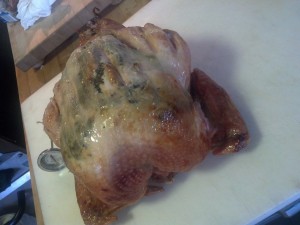 My turkey roasting technique that is!!
My turkey roasting technique that is!!
I recently read a blog post by Darya Pino of Summer Tomato on How to Become a Great Cook Without Being a Chef. She’s right! You don’t need to be a chef to cook really good food. But, (and this is a big BUT sticking out) you do need a few of Chef’s techniques.
When I studied at the California Culinary Academy the focus was on learning technique, not so much on recipes. The philosophy is simple: If you understand how and when to incorporate each ingredient into a dish you can create your own recipes. And it is true!! By learning HOW to cook, not only was I able to create my own dishes, it became much easier to follow a recipe. Sounds silly I know, most recipes are well research and clearly written. Yet, when I incorporated my knowledge of cooking with say – Betty Crocker – goodness, the dish took on new textures and flavors.
It is this nuanced change that I am referring to when I say Upside Down and Backwards. Because that is exactly what I did. I roasted my turkey upside down and backwards. Follow me here, this is where it starts to get good.
The challenge for every cook on Thanksgiving is to cook the turkey making sure that the legs & thighs are cooked while keeping the breast meat from drying out and becoming stringy. Americas Test Kitchen performed a definitive study last year on turkey roasting trying all of the different roasting techniques and endorsed a good, albeit cumbersome, technique for preparing your bird: they cut the turkey into pieces and roasted the legs and thighs separately from the breast. Boo, I say. That takes away all of the fun of carving for dad!
I acknowledge the reasoning behind this approach but promise you one better. Actually FOUR better!! Now Darya Pino, this is where being a chef does make a difference. Chef Suzanne and I put our heads together determined to roast a turkey whole while keeping it moist and giving it great flavor . . . and we nailed it the first time out. Here’s what we did.
BRINING: Brining is a technique where the turkey is submerged in a saturated water mixture containing salt, sometimes sugar and oftentimes spices. It is a fun technique but takes time and refrigerator space. Sometime in the future I will share a recipe with you but for now I give you this short cut: Butterball. Yep, we bought a Butterball turkey simply because it was already brined. Butterball has been in business since before I gnawed on my first turkey leg and I trust their technique. I was not wrong then and I am not wrong now. Their birds are flavorful. But alas, I have had dry Butterballs before. So . . .
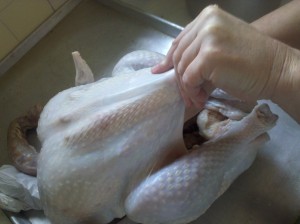 HERBED BUTTER: Here is a technique I just love. Suzanne and I took a half pound of soft butter and mixed in about 6 cloves of chopped garlic, salt and pepper to taste, and a small bunch each of Sage, Marjoram and Thyme chopped fine. We then loosened the skin covering the breast of the turkey and rubbed the Herbed Butter directly on to the meat. A lot of people will season the skin leaving the meat unadorned. I use this technique nearly every time I roast fowl. It always amazes!! I suggest that you thaw the bird the night before, pat it dry, rub in the herbed butter and leave it covered with plastic in the refrigerator overnight. Then it is all ready to pop in the oven on Thursday with a little extra flavor-infusing time.
HERBED BUTTER: Here is a technique I just love. Suzanne and I took a half pound of soft butter and mixed in about 6 cloves of chopped garlic, salt and pepper to taste, and a small bunch each of Sage, Marjoram and Thyme chopped fine. We then loosened the skin covering the breast of the turkey and rubbed the Herbed Butter directly on to the meat. A lot of people will season the skin leaving the meat unadorned. I use this technique nearly every time I roast fowl. It always amazes!! I suggest that you thaw the bird the night before, pat it dry, rub in the herbed butter and leave it covered with plastic in the refrigerator overnight. Then it is all ready to pop in the oven on Thursday with a little extra flavor-infusing time.
UPSIDE DOWN: I like this technique a lot especially with turkeys because of their size. Bigger is better may be the American motto but it can play hell when roasting. Three factors come in to play when roasting: Time, Temperature and Gravity. With gravity being the only constant. Since I cannot change the effect of gravity I decided to use it to my advantage. I roasted my bird Up Side Down!! The effect was simple, all of the juices collected in the breast meat instead of the back of the bird. Yum!!
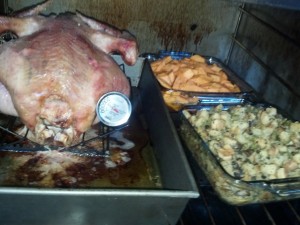 TIME & TEMPERATURE: Here’s the secret sword thrust of roasting. Start your turkey at 450° F. That’s right, low and slow works for BBQ meats that are full of collagen and you want to fall apart. Starting hot and fast . . . well . . . it’s better, that’s all. Actually this is how I understand what is happening. Collagen, the ‘moisture’ in the bird, is water soluble. In a slow oven, low temperature, the water temperature in the meat rises slowly and begins to drain from the meat carrying the collagen away with it, essentially drying out the meat. The longer the meat temperature stays at or near the boiling point of water the dryer the meat will become. Starting in a hot oven will push the meat temperature passed this mark more quickly leaving less time for the collagen to dissolve into the water.
TIME & TEMPERATURE: Here’s the secret sword thrust of roasting. Start your turkey at 450° F. That’s right, low and slow works for BBQ meats that are full of collagen and you want to fall apart. Starting hot and fast . . . well . . . it’s better, that’s all. Actually this is how I understand what is happening. Collagen, the ‘moisture’ in the bird, is water soluble. In a slow oven, low temperature, the water temperature in the meat rises slowly and begins to drain from the meat carrying the collagen away with it, essentially drying out the meat. The longer the meat temperature stays at or near the boiling point of water the dryer the meat will become. Starting in a hot oven will push the meat temperature passed this mark more quickly leaving less time for the collagen to dissolve into the water.
Here’s the trick behind the technique. Start your turkey, upside down in a rack, in a 450° F oven. Leave it there until the bird ‘starts talking to you.’ That is, until you can here the turkey snap, crackle and pop. About one half hour. Then turn the oven down to 325° F. About 2 hours in to the roasting process check the thigh meat with a meat thermometer. Your goal is 175 -180° F for the leg and thigh and 170° F for the breast. My 13 lb. bird took about 3 hours to cook completely through and MAN was it good.
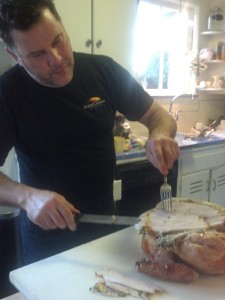 After the turkey reaches the desired internal remove it from the oven and let stand about 20 minutes before carving. Suzanne and I had great success with this bird. Both the white meat and dark meat were moist and flavorful.
After the turkey reaches the desired internal remove it from the oven and let stand about 20 minutes before carving. Suzanne and I had great success with this bird. Both the white meat and dark meat were moist and flavorful.
I hope that your bird turns out as great as mine did. Stay tuned this week for Pan Gravy and Side Dish recipes.
Until then,
Eat Well and Smile Often!!
tj
p.s. I get two turkeys this year ;-)

 I recently got called on my cooking BS.
I recently got called on my cooking BS. Now to the title of this piece and how Pilav became Pilaf. In 1533, at the age of fourteen, Catherine de Medici of Italy married Henry II, king of France. Henry, to our benefit you’ll soon discover, was much more interested in his mistress Diane de Poitiers than his new bride. Catherine as a result was excluded from politics and all things court like. Instead of staying by her husband’s side she traveled the country with her entourage. Here comes the good part. The Italians, being the great travelers and traders they are, brought back not only goods for commerce but great heaps of culture from around the globe. In Catherine’s entourage were chefs schooled in cross cultural cooking techniques and the dishes they inspired. As they progressed around France, Catherine chefs would require the assistance of local cooks to prepare the Queen’s meals. Catherine moved on but the cooking techniques remained, Pilaf included. While there has been some trifling debate as to whether Catherine actually had this much effect on French cuisine, those of us who study it can precisely time its rise to the Renaissance period. So there!
Now to the title of this piece and how Pilav became Pilaf. In 1533, at the age of fourteen, Catherine de Medici of Italy married Henry II, king of France. Henry, to our benefit you’ll soon discover, was much more interested in his mistress Diane de Poitiers than his new bride. Catherine as a result was excluded from politics and all things court like. Instead of staying by her husband’s side she traveled the country with her entourage. Here comes the good part. The Italians, being the great travelers and traders they are, brought back not only goods for commerce but great heaps of culture from around the globe. In Catherine’s entourage were chefs schooled in cross cultural cooking techniques and the dishes they inspired. As they progressed around France, Catherine chefs would require the assistance of local cooks to prepare the Queen’s meals. Catherine moved on but the cooking techniques remained, Pilaf included. While there has been some trifling debate as to whether Catherine actually had this much effect on French cuisine, those of us who study it can precisely time its rise to the Renaissance period. So there!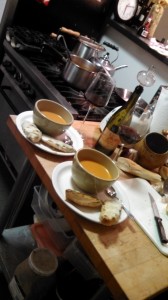 What to do? What to do? What to do? A winter’s day ripe for hot tomato soup and grilled cheese sandwiches. But, tomato season is over and I just can’t get my self to buy those pale pink, baseball hard orbs the grocer labels as tomatoes. I remember my mother trying to get the Kids to eat vegetables during the winter and serving us these rock hard, white tomatoes with a wedge of iceberg lettuce and an oversize portion of bleu cheese dressing. Yes, health was on her mind.
What to do? What to do? What to do? A winter’s day ripe for hot tomato soup and grilled cheese sandwiches. But, tomato season is over and I just can’t get my self to buy those pale pink, baseball hard orbs the grocer labels as tomatoes. I remember my mother trying to get the Kids to eat vegetables during the winter and serving us these rock hard, white tomatoes with a wedge of iceberg lettuce and an oversize portion of bleu cheese dressing. Yes, health was on her mind.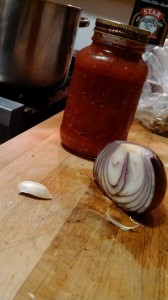 Anyway, this weekend the rain was coming down and Suzanne and I were hankering for something warm and satisfying. Tomato soup sounded great but alas . . . no fresh tomatoes. Wait!! That is not entirely true. While they were not fresh off the vine in the minute, I did have a jar of tomatoes that I put up right after picking. I reached into my pantry and came out with a quart jar of lovely ripe, stewed tomatoes. One of the great challenges of having an edible garden is using all of its produce. This year I went heavily into tomatoes and was rewarded with a bumper crop. Take a minute to review my
Anyway, this weekend the rain was coming down and Suzanne and I were hankering for something warm and satisfying. Tomato soup sounded great but alas . . . no fresh tomatoes. Wait!! That is not entirely true. While they were not fresh off the vine in the minute, I did have a jar of tomatoes that I put up right after picking. I reached into my pantry and came out with a quart jar of lovely ripe, stewed tomatoes. One of the great challenges of having an edible garden is using all of its produce. This year I went heavily into tomatoes and was rewarded with a bumper crop. Take a minute to review my 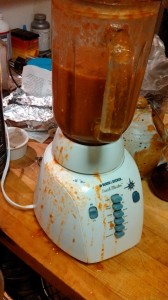 The next step is my favorite. I like to blend my soups. Now some cooks like to use immersion blenders, those little electric motor sticks with wimpy little blades that barely move your soup around the pot. Me, I like using a blender on low speed until I get the texture I want. And . . . every once in a while I forget to keep my hand on the lid and oops, I get a little messy. Occasionally I will strain my soup to remove any extra chunky bits. I tried that this time and was not happy with the results so I dumped the solids back into the pot and was happy that I did.
The next step is my favorite. I like to blend my soups. Now some cooks like to use immersion blenders, those little electric motor sticks with wimpy little blades that barely move your soup around the pot. Me, I like using a blender on low speed until I get the texture I want. And . . . every once in a while I forget to keep my hand on the lid and oops, I get a little messy. Occasionally I will strain my soup to remove any extra chunky bits. I tried that this time and was not happy with the results so I dumped the solids back into the pot and was happy that I did.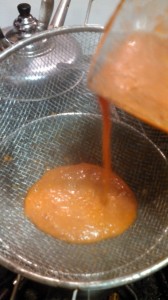 Giving the puree’ a taste test I found the soup to be a little flat so I added just a pinch of kosher salt. Wow!! Did that pick the flavors right up. Normally I would add some acid to brighten the flavor but the tomatoes brought just enough to the dish so no vinegar was needed.
Giving the puree’ a taste test I found the soup to be a little flat so I added just a pinch of kosher salt. Wow!! Did that pick the flavors right up. Normally I would add some acid to brighten the flavor but the tomatoes brought just enough to the dish so no vinegar was needed.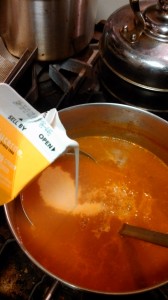 Fortunately for me she did not stop there. Suzanne also whipped up a little fresh pesto which she used to coat a slice of freshly baked baguette. On top of which she added slices of Gruyere and Mozzarella. Get that all melty in the toaster oven and Man!! What a meal.
Fortunately for me she did not stop there. Suzanne also whipped up a little fresh pesto which she used to coat a slice of freshly baked baguette. On top of which she added slices of Gruyere and Mozzarella. Get that all melty in the toaster oven and Man!! What a meal. So, this last rainy weekend, Suzanne and I tucked into freshly baked bread topped with pesto and cheese with a steaming hot bowl of tomato cream soup. Took the shivers right away. My advice is: If you find yourself wanting for grilled cheese and soup one rainy day, dig a little deeper into the pantry and see just what might make make the day a little brighter.
So, this last rainy weekend, Suzanne and I tucked into freshly baked bread topped with pesto and cheese with a steaming hot bowl of tomato cream soup. Took the shivers right away. My advice is: If you find yourself wanting for grilled cheese and soup one rainy day, dig a little deeper into the pantry and see just what might make make the day a little brighter.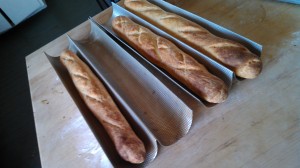 I love bread. I love bread with butter. I love bread with olive oil . . . and balsamic vinegar!! I love bread with cheese. I love bread with cheese and tomatoes and basil!! I like bread in rolls. I like bread in loaves. I like to slice it, dice it, rip it and chew it. I like it as the bookends of my sandwich or as a crusty chunk in my soup. I like it for breakfast, for lunch and for dinner. I like it when I am hungry and even when I am not!! I like to toast it, soak it, dip it and fry it. Almost any way I can fix it I will try it!!
I love bread. I love bread with butter. I love bread with olive oil . . . and balsamic vinegar!! I love bread with cheese. I love bread with cheese and tomatoes and basil!! I like bread in rolls. I like bread in loaves. I like to slice it, dice it, rip it and chew it. I like it as the bookends of my sandwich or as a crusty chunk in my soup. I like it for breakfast, for lunch and for dinner. I like it when I am hungry and even when I am not!! I like to toast it, soak it, dip it and fry it. Almost any way I can fix it I will try it!!